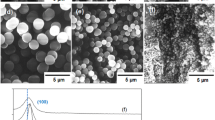Abstract
Sub 2-μm monodisperse mesoporous silica spheres (MMSS) were synthesized using a mixed template system in a MeOH/H2O solution. 1-Dodecylamine (DDA) and polymeric type Jeffamine surfactants, including D2000, D4000, and T5000, were employed as templates. These mixed template syntheses realized to gain MMSS materials with good spherical shape and uniform particle size. When the MeOH/H2O (v/v) ratio was controlled between 2.5:1 and 3.0:1, mesoporous silica spheres of 2.10–2.35 μm with excellent dispersibility can be obtained. Depending on the surfactant chain length of Jeffamine, hydrothermal aging pH (4–9), time (12–24 h), and temperature (80–140 °C), MMSS with large-pore sizes (up to 14.3 nm), surface areas (153–791 m2/g), and pore volumes (0.47–1.28 cm3/g) can be synthesized.
Highlight
-
Monodisperse mesoporous silica spheres.









Similar content being viewed by others
References
Yoo WC, Stein A (2011) Solvent effects on morphologies of mesoporous silica spheres prepared by pseudomorphic transformations. Chem Mater 23:1761–1767
Zukal A, Thommes M, Čejka J (2007) Synthesis of highly ordered MCM-41 silica with spherical particles. Microporous Mesoporous Mater 104:52–58
Yu J, Zhao L, Cheng B (2006) Preparation of monodispersed microporous SiO2 microspheres with high specific surface area using dodecylamine as a hydrolysis catalyst. J Solid State Chem 179:226–232
Zhao D, Huo Q, Feng J, Chmelka BF, Stucky GD (1998) Nonionic triblock and star diblock copolymer and oligomeric surfactant syntheses of highly ordered, hydrothermally stable, mesoporous silica structures. J Am Chem Soc 120:6024–6036
Shimogaki T, Tokoro H, Tabuchi M, Koike N, Yamashina Y, Takahashi M (2016) Large-scale preparation of morphology-controlled microporous silica particles via gradual injection of reactants with different surfactants. J Sol–Gel Sci Technol 79:440–446
Sayari A, Hamoudi S, Yang Y (2005) Applications of pore-expanded mesoporous silica. 1. removal of heavy metal cations and organic pollutants from wastewater. Chem Mater 17:212–216
Sun J-H, Coppens M-O (2002) A hydrothermal post-synthesis route for the preparation of high quality MCM-48 silica with a tailored pore size. J Mater Chem 12:3016–3020
Kaneko T, Nagata F, Kugimiya S, Kato K (2018) Morphological control of mesoporous silica particles by dual template method. Ceram Int 44:20581–20585
Hsu Y-C, Hsu Y-T, Hsu H-Y, Yang C-M (2007) Facile synthesis of mesoporous silica SBA-15 with additional intra-particle porosities. Chem Mater 19:1120–1126
Birault A, Molina E, Carcel C, Bartlett J, Marcotte N, Toquer G, Lacroix-Desmazes P, Gerardin C, Chi Man MWong (2019) Synthesis of lamellar mesostructured phenylene-bridged periodic mesoporous organosilicas (PMO) templated by polyion complex (PIC) micelles. J Sol–Gel Sci Technol 89:189–195
Park I, Pinnavaia TJ (2009) Large-pore mesoporous silica with three-dimensional wormhole framework structures. Microporous Mesoporous Mater 118:239–244
Park I, Wang Z, Pinnavaia TJ (2005) Assembly of large-pore silica mesophases with wormhole framework structures from α,ω-diamine porogens. Chem Mater 17:383–386
Hossain K-Z, Sayari A (2008) Synthesis of onion-like mesoporous silica from sodium silicate in the presence of α,ω-diamine surfactant. Microporous Mesoporous Mater 114:387–394
May A, Pasc A, Stebe MJ, Gutierrez JM, Porras M, Blin JL (2012) Tailored jeffamine molecular tools for ordering mesoporous silica. Langmuir 28:9816–9824
May-Masnou A, Pasc A, Stébé MJ, Gutiérrez JM, Porras M, Blin JL (2013) Solubilization of decane into gemini surfactant with a modified Jeffamine backbone: design of hierarchical porous silica. Microporous Mesoporous Mater 169:235–241
Riachy P, Lopez G, Emo M, Stebe MJ, Blin JL, Ameduri B (2017) Investigation of a novel fluorinated surfactant-based system for the design of spherical wormhole-like mesoporous silica. J Colloid Interface Sci 487:310–319
Chunyan L, Caiyun G, Dongxue Z, Jing W, Jiashuo L, Zhaobin L (2015) Modified jeffamine molecular tools for ordered mesoporous and super-micorporous silica microsphere particles. Chin J Inorg Chem 31:954–960
Du Y, Cheng L, Chen L, He Y, Wu Y, He S, Ke Y (2017) Preparation of sub-2 μm large-pore monodispersed mesoporous silica spheres using mixed templates and application in HPLC. Microporous Mesoporous Mater 265:234–240
Funding
This work was supported by the National Natural Science Foundation of China (grant no. 21375038).
Author information
Authors and Affiliations
Corresponding author
Ethics declarations
Conflict of interest
The authors declare that they have no conflict of interest.
Additional information
Publisher’s note Springer Nature remains neutral with regard to jurisdictional claims in published maps and institutional affiliations.
Rights and permissions
About this article
Cite this article
Wang, Q., Wang, H., Wu, Y. et al. Pore size control of monodisperse silica particles by dual template sol–gel method. J Sol-Gel Sci Technol 94, 186–194 (2020). https://doi.org/10.1007/s10971-019-05152-7
Received:
Accepted:
Published:
Issue Date:
DOI: https://doi.org/10.1007/s10971-019-05152-7




